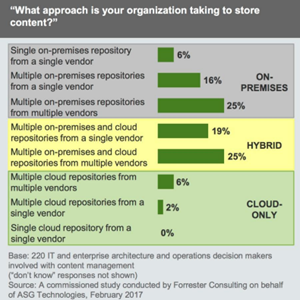How to Overcome Today's Enterprise Content Challenges
Enterprise Content Management (ECM) has lately been shaken up by some eyebrow- raising claims, like Gartner’s Michael Woodbridge saying “ECM is now dead. It’s been replaced by the term Content Services”, and the acquisitions and divestitures of some leading ECM vendors such as HP, Lexmark, and Documentum. On top of this tidal shift, a glut of enterprises that leverage the power of cloud computing is on the rise, in fact, the cloud-based ECM market size is expected to grow from USD 9.77 Billion in 2017 to USD 34.42 Billion by 2022.
raising claims, like Gartner’s Michael Woodbridge saying “ECM is now dead. It’s been replaced by the term Content Services”, and the acquisitions and divestitures of some leading ECM vendors such as HP, Lexmark, and Documentum. On top of this tidal shift, a glut of enterprises that leverage the power of cloud computing is on the rise, in fact, the cloud-based ECM market size is expected to grow from USD 9.77 Billion in 2017 to USD 34.42 Billion by 2022.
I do not know for sure whether enterprise content management is not adequate enough as a term or the capabilities of the ECM tools have outgrown its definition, but what we all know for sure is that change is inevitable, and the ECM world has reached the tipping point where vendors have no other choice but to change. Therefore, this article will discuss what the most emerging trends are and how they address the most common enterprise challenges.
Hybrid Cloud
A recent survey conducted by Forrester Consulting for ASG Technologies nicely portrayed the  status quo of the struggles enterprises are facing when it comes to controlling their content. The findings from the study represent the voice of a total of 220 IT, enterprise architecture, and operations decision-makers who are involved with content management. Nearly one-third of respondents stated that sharing content with external parties is becoming mainstream. In that regard, expanding regulatory and compliance demands and an increased urgency to protect both customer and enterprise data are the issues cited in the report. In other words, they need to enable both their internal and external stakeholders to take part in the collaborative content co-creation or review of the internal business process in a secure manner.
status quo of the struggles enterprises are facing when it comes to controlling their content. The findings from the study represent the voice of a total of 220 IT, enterprise architecture, and operations decision-makers who are involved with content management. Nearly one-third of respondents stated that sharing content with external parties is becoming mainstream. In that regard, expanding regulatory and compliance demands and an increased urgency to protect both customer and enterprise data are the issues cited in the report. In other words, they need to enable both their internal and external stakeholders to take part in the collaborative content co-creation or review of the internal business process in a secure manner.
To tackle those regulatory and statutory requirements, most enterprises have started to captivate the power of the cloud. One of the most important takeaways from the same report is that while enterprise content management today is predominantly deployed on-premises, within the next two years, 90% of organizations will be using cloud-based content management systems, either as a primary or hybrid approach.
Forrester’s study is not the only source that tells us that more enterprises will manage content on hybrid systems (cloud/on-premise). In fact, Gartner predicted that half of the enterprises will embrace the hybrid approach for content management. Additionally, during our interview with OpenText CMO Adam Howatson, he agreed that a hybrid approach is a current trend, saying: “It’s very much a hybrid world still today. It’s not a binary decision for companies, not like everything goes to a cloud or everything is on premises as it is very much a hybrid approach today.” Then, he furthered his prediction in this regard: “But I think, we are going to see continued and increasing options of cloud-based services whether those are NET services or SaaS type of applications, and I think that will be another major trend as well.”
Another issue addressed by a cloud-based ECM was the fact that deploying an ECM solution on-premises requires a heavy investment in network infrastructure and physical assets as on-premises ECM applications can cost $1 million or more, with $200,000 or more being invested in hardware alone. With moving ECM to the cloud, on the other hand, organizations reduce their ECM TCO [total cost of ownership] by getting rid of up-front IT costs and maintenance expenses associated with on-premises technologies.
Additionally, ever-increasing consumer expectations eventually hit enterprises as well. By the year 2020, it is estimated that Millennials will form 75% of the global workforce, and this new generation is not known for their high tolerance of cumbersome and lacking features, as they are used to working with fast technology solutions through their own personal devices. To provide this kind of flexibility and productivity with a single monolithic approach has become impossible whereas cloud-based ECM solutions address this issue by supporting the delivery of flexible, granular, purposeful applications. Therefore, many enterprises today, shift from the legacy ECM solutions to the cloud so they can keep up with market dynamics and the organizational needs for content in digital business.
To summarize the main challenges that the cloud shift could address,
-
Changes in regulatory and statutory requirements
-
A heavy investment in network infrastructure and physical assets
-
A need for rapid innovation
-
Shifts in organizational needs for content that is related to changes in consumer behavior
It is worth noting that these issues can be addressed only with cloud-native content platforms. The reason why I wanted to emphasize this is because while some ECM solutions were wading into the cloud foray, they simply moved their traditional slack into the cloud as if it is just the extension of legacy ECM software hosted in the cloud. However, the legacy ECM solutions hosted in the “cloud” couldn’t move the needle when it comes to truly addressing those challenges enterprises are facing, as true modern cloud elasticity is needed for that purpose.
Content Services
First off, the premise of Content Services is to bring together architecture supportive of on- premises and hybrid cloud services, a multi-repository approach to managing content regardless of its source repository, and intelligent functions like enterprise search to create agile, cost effective solutions. The reason why this term can replace ECM, according to Gartner, is because Content Services provide a more practical and multi-repository solution whereas ECM has been hidden in a single repository world. As AIIM (Association for Information and Image Management) puts it, it is “neither a single technology nor a methodology nor a process, it is a dynamic combination of strategies, methods, and tools used to capture, manage, store, preserve and deliver information supporting key organizational processes through its entire lifecycle”.
premises and hybrid cloud services, a multi-repository approach to managing content regardless of its source repository, and intelligent functions like enterprise search to create agile, cost effective solutions. The reason why this term can replace ECM, according to Gartner, is because Content Services provide a more practical and multi-repository solution whereas ECM has been hidden in a single repository world. As AIIM (Association for Information and Image Management) puts it, it is “neither a single technology nor a methodology nor a process, it is a dynamic combination of strategies, methods, and tools used to capture, manage, store, preserve and deliver information supporting key organizational processes through its entire lifecycle”.
Now let’s look into the enterprise challenges that content services could address. Forrester’s study revealed that 93 percent of companies are using multiple repositories to store content, with 31 percent using more than five systems to manage it. Additionally, the findings demonstrated that in the recent two years, 50 percent of respondents have seen a more than 10 percent rise in the volume of unstructured data. At the end of the day, finding the balance between compliance requirements and employee’s needs for ease of use represents a huge challenge for many organizations. So the key differentiators of business content services, including analytics, file sharing, collaboration, and a focus on usability, could address these challenges.
Everything from inventory reports to service contracts to customer correspondence should all be connected so authorized employees would know the whole story on any initiative or case to meet their target audience expectations at the edge. Due to their modern architecture, content services can provide the same consistent control and governance on data generated across company borders. That way, organizations can enable their employees to easily automate horizontal processes while delivering a frictionless customer experience.
Cognitive Analytics
The need for rich data and a centralized repository for explicit customer data and implicit customer insights are on the rise. To meet this demand, there has been a cut-throat competition among major ECM vendors as almost all of them are beefing up their platforms with cognitive analytics. To give an example, last year, OpenText CTO and CEO Mark Barrenechea publicly took aim at IBM’s cognitive learning engine, Watson, pointing out its closed ecosystem, limited deployment options, and high cost while claiming their open source cognitive analytics platform Magellan is able to deal with 90 percent of the issues that businesses want to address through analytics by analyzing both structured and unstructured information.
Speaking of OpenText and cognitive analytics, during our interview with OpenText CMO Adam Howatson, we picked his brain on the current trends of the market and where will we see the most innovations in the coming year. He said: “90 percent of the information within an organization has been unstructured or semi-structured content, including contracts, power point presentations, word documents, and conversational discussions in the audio format. They all constitute the mass majority of information within the Enterprise.” Therefore, he believes that businesses need a cognitive analytics platform that is capable of conducting unstructured content analysis across more than tens of thousands of documents and giving insights on, for instance, what language their customers are using, when they interact with businesses, what specifically they are asking for, what types of problems they are solving, what sort of solutions they are using, and how businesses have responded to them so far. When it comes to the reason why these types of insights would be important for him as a business owner or a decision maker, he said: “I want to correlate all of that data and surface the major trends because that will help inform me in the way that I take our products to market and I do our positioning and messaging.” For that reason, he claims “cognitive solutions and unstructured content analytics will be one of the major trends in the coming years.” I really liked the way Howatson puts this by saying that adding cognitive analytics capabilities to a cloud-based solution ultimately provides organizations with a meaningful productive output instead of a wall of numbers.
Howatson, we picked his brain on the current trends of the market and where will we see the most innovations in the coming year. He said: “90 percent of the information within an organization has been unstructured or semi-structured content, including contracts, power point presentations, word documents, and conversational discussions in the audio format. They all constitute the mass majority of information within the Enterprise.” Therefore, he believes that businesses need a cognitive analytics platform that is capable of conducting unstructured content analysis across more than tens of thousands of documents and giving insights on, for instance, what language their customers are using, when they interact with businesses, what specifically they are asking for, what types of problems they are solving, what sort of solutions they are using, and how businesses have responded to them so far. When it comes to the reason why these types of insights would be important for him as a business owner or a decision maker, he said: “I want to correlate all of that data and surface the major trends because that will help inform me in the way that I take our products to market and I do our positioning and messaging.” For that reason, he claims “cognitive solutions and unstructured content analytics will be one of the major trends in the coming years.” I really liked the way Howatson puts this by saying that adding cognitive analytics capabilities to a cloud-based solution ultimately provides organizations with a meaningful productive output instead of a wall of numbers.
To put the importance of cognitive analytics into perspective, he shared this example with CMS-Connected: “Say, I’m paying 10 million dollars a year to haul 50 petabytes of data. I don’t want to do that for compliance and corporate memory reasons anymore, I want to put that data to work to inform my market, to inform my customer interactions, to inform my selling cycle, to inform my engineering divisions, and I think that will be a pretty profound pivot.”
My POV
As the pace of business and the need for collaboration persist to accelerate, enterprises were struggling with managing and protecting their sensitive content as well as enabling their multi-cultural teams to collaborate on the same project in real time. It turned out the ECM solutions were offering organizations the illusion of control because traditional ECM solutions missed out on the social aspect of content such as collaboration and integration. That’s why leading ECM vendors started rethinking how enterprise content is managed. To address all these issues, they leveraged usability, customer success programs, analytics, and simplified file sharing and collaboration capabilities.
These fundamental changes will still undergo an enormous change. The results of this rethinking process will go beyond categorizing large volumes of content exponentially faster than humans, though. While we are going to see more and more investments from companies in these specific emerging trends listed above, they won’t be the only areas of focus for investments as the table stake technologies like mobile and social will also continue to grow in the enterprise content management space.

Venus Tamturk
Venus is the Media Reporter for CMS-Connected, with one of her tasks to write thorough articles by creating the most up-to-date and engaging content using B2B digital marketing. She enjoys increasing brand equity and conversion through the strategic use of social media channels and integrated media marketing plans.